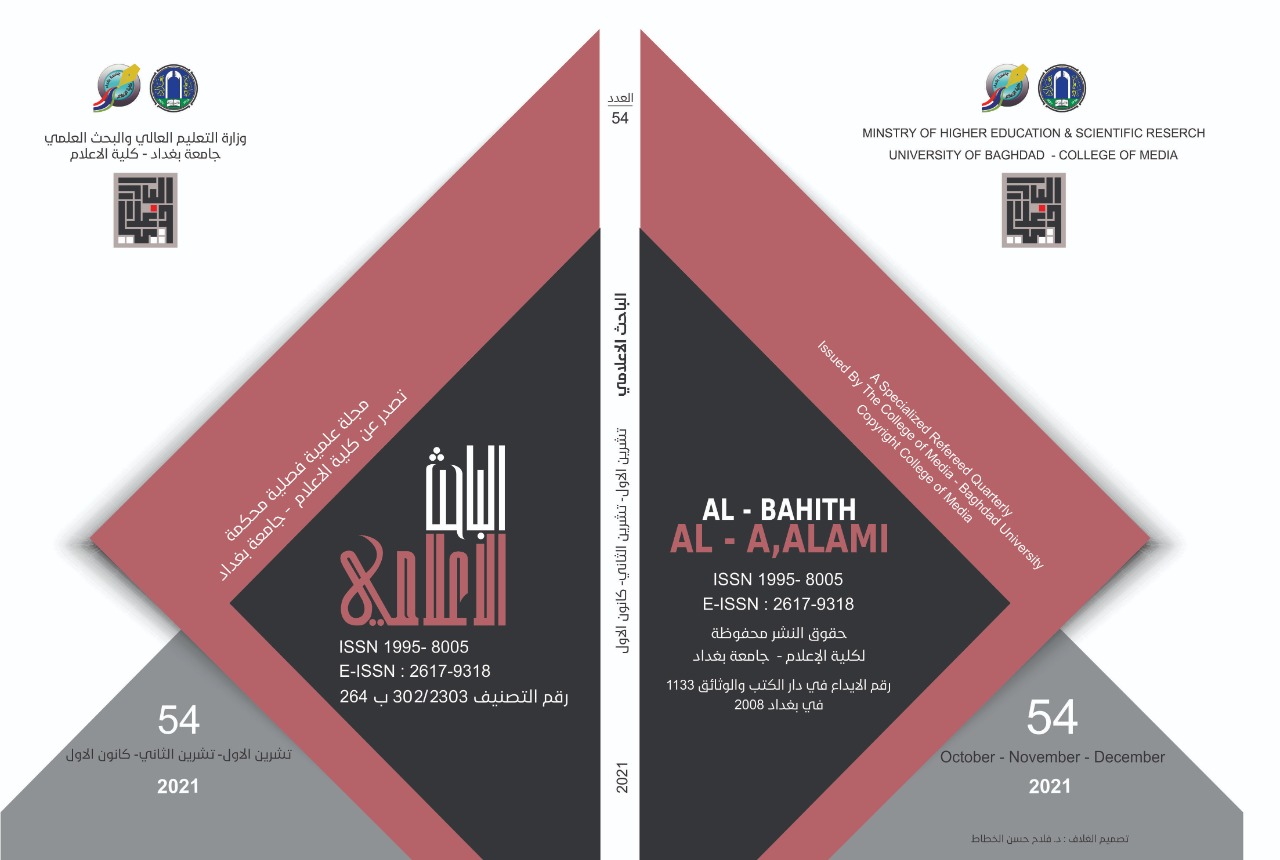Motives for public exposure to specialized sports satellite channels and the gratifications achieved from it
A survey study on the public of the city of Baghdad
DOI:
https://doi.org/10.33282/abaa.v13i54.844Keywords:
motives; exposure; audience; specialized sports satellite channels; gratificationAbstract
Motives for public exposure to specialized sports satellite channels and the gratifications achieved about it - Research presented by (Dr. Dr. Laila Ali Jumaa), Imam Al-Kadhim College (peace be upon him) - Department of Information-2021.
The research aims to know the extent of public exposure to specialized sports satellite channels, and what gratifications are achieved from them, and to reach scientific results that give an accurate description of exposure, motives and gratifications verified by that exposure, and the research objectives are summarized in the following:
- Revealing the habits and patterns of public exposure to specialized sports satellite channels?
- Identify the reasons for the public's preference for specialized sports satellite channels?
- Disclose the motives and gratifications achieved by the public from exposure to specialized sports satellite channels?
The researcher used the survey method to collect data by designing a questionnaire, as a tool to reveal the motives and gratifications achieved among the public from exposure to specialized sports satellite channels. areal), and it was paired with the non-probability (purpose) sample from the audience groups that watch specialized sports satellite channels, as it achieves the research objectives, and the research reached several results that can be summarized as follows:
- The results of the research showed that the majority of the respondents watched the specialized sports satellite channels, on a continuous basis, “always” with a number of repetitions amounting to (120%), respondents and at a rate of (60%).
- The results of the research showed that the respondents prefer watching specialized sports satellite channels in the second evening period from (6 pm - 10 pm), and the number of respondents was (127), with a percentage of (63.5%).
- There is a statistically significant correlation between the public's exposure to specialized sports satellite channels and the related motives of this exposure, and the degree of need or motivation for exposure to specialized sports satellite channels is at a high level.
- There is a statistically significant correlation between the public's motives for exposure to specialized sports satellite channels and the resulting gratifications from this exposure. The result indicates that the degree of saturation achieved from exposure to specialized sports satellite channels was at a high level.
References
أبو النجا العمري. (1986). الاتصال في الخدمة الجامعية. دمشق: دار المعرفة الجامعية.
أفنان محمد شعبان. (2018). فاعلية البرامج التلفزيونية الرياضية في تنمية الثقافة الرياضية لدى الشباب: دراسة ميدانية. مجلة الباحث الإعلامي، 10(40)، الصفحات 131-142.
بركات عبد العزيز . (2012). مناهج البحث الاعلامي: الاصول النظرية ومهارات التطبيق. القاهرة: دار الكتاب الحديث.
حسن عماد مكاوي. (2009). نظريات الإعلام. القاهرة: الدار العربية للنشر والتوزيع.
حسن عماد مكاوي ، و ليلى حسين السيد. (2006). الإتصال ونظرياته المعاصرة (المجلد 6). القاهرة: الدار المصرية اللبنانية.
حسن عماد مكاوي، و ليلي حسين السيد. (1989). علم النفس التربوي. مصر: دار الفكر العربي.
حمدي عبد الظاهر . (2020). القنوات الفضائية المتخصصة. الجزائر: دار ضمة للنشر والتوزيع.
خالد محمود الزيود. (2013). دور مشاهدة القنوات الفضائية الرياضية في نشر الثقافة الرياضية لدى طلبة جامعة اليرموك. مجلة الجامعة الاسلامية للدراسات التربوية والنفسية، 214.
محمود حسن اسماعيل. (2011). مناهج البحث الإعلامي. القاهرة: دار الفكر العربي.
هادي الهيتي نعمان . (1988). الإتصال الجماهيري: المنظور الجديد، الموسوعة الصغيرة. بغداد: دار الشؤون الثقافية.
Referenses
Conway, J. C. (1991). Psychological Predictors of T.V Viewing Motivation. Communication Research, 18(4), pp. 443-463.
Rubin, A. M. (1985). Uses and Gratifications: Quasificational Analysis In g R Dominick Sage Fletcher eds Broadcasting. Research Methods Massachusetts: S Bacon Inc.
Abu Naga Omari. (1986). Contact the university service. Damascus: University Knowledge House.
Afnan Mohamed Shaaban. (2018). The effectiveness of sports television programs in developing sports culture among youth: a field study. Journal of the Media Researcher, 10(40), pages 131-142.
Barakat Abdel Aziz. (2012). Media research methods: theoretical foundations and application skills. Cairo: Modern Book House.
Hassan Emad Makkawi. (2009). media theories. Cairo: Arab House for Publishing and Distribution.
Hassan Imad Makkawi, and Laila Hussein Al-Sayed. (2006). Communication and its contemporary theories (Volume 6). Cairo: The Egyptian Lebanese House.
Hassan Emad Makkawi, and Layla Hussein El-Sayed. (1989). Educational psychology. Egypt: Arab Thought House.
Hamdi Abdel-Zaher. (2020). Specialized satellite channels. Algeria: Dar Damma for Publishing and Distribution.
Khaled Mahmoud Al-Zyoud. (2013). The role of watching sports satellite channels in spreading sports culture among Yarmouk University students. Journal of the Islamic University of Educational and Psychological Studies, 214.
Mahmoud Hassan Ismail. (2011). Media research methods. Cairo: Arab Thought House.
Hadi Al-Hiti Noaman. (1988). Mass Communication: The New Perspective, The Small Encyclopedia. Baghdad: House of Cultural Affairs.
Downloads
Published
Issue
Section
License
Copyright (c) 2021 author

This work is licensed under a Creative Commons Attribution 4.0 International License.
Authors retain copyright and grant the journal right of first publication with the work simultaneously licensed under a Creative Commons Attribution License (CC BY 4.0) that allows sharing the work with recognition of authorship and initial publication in ABBA journal.


















